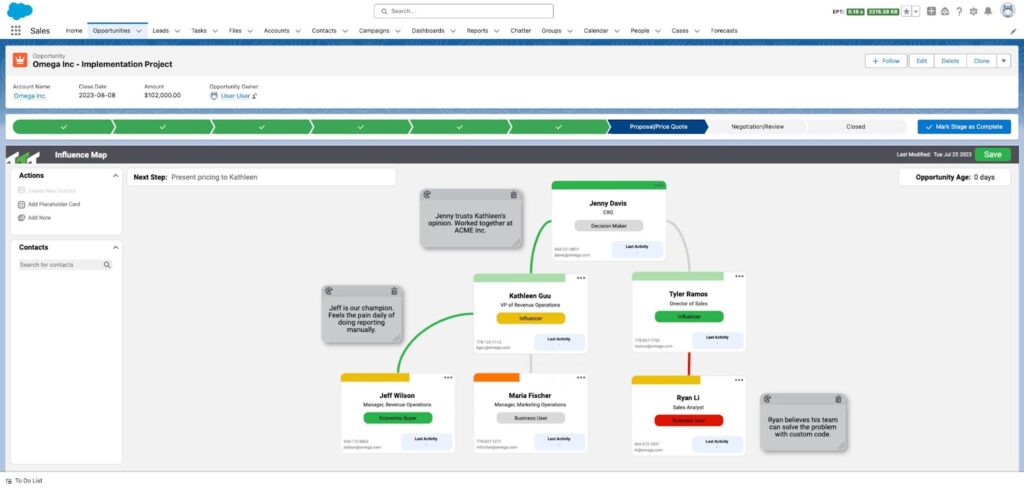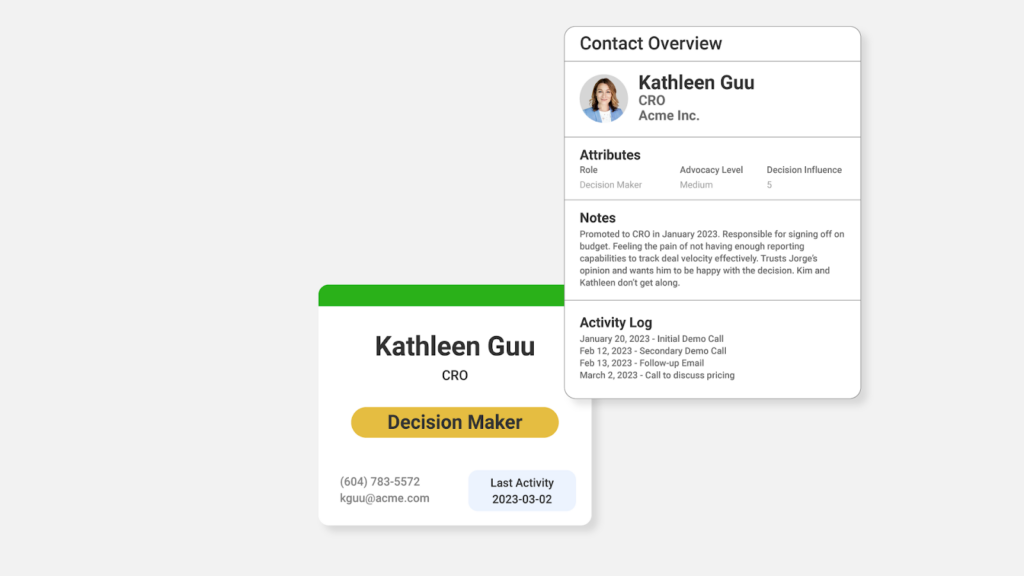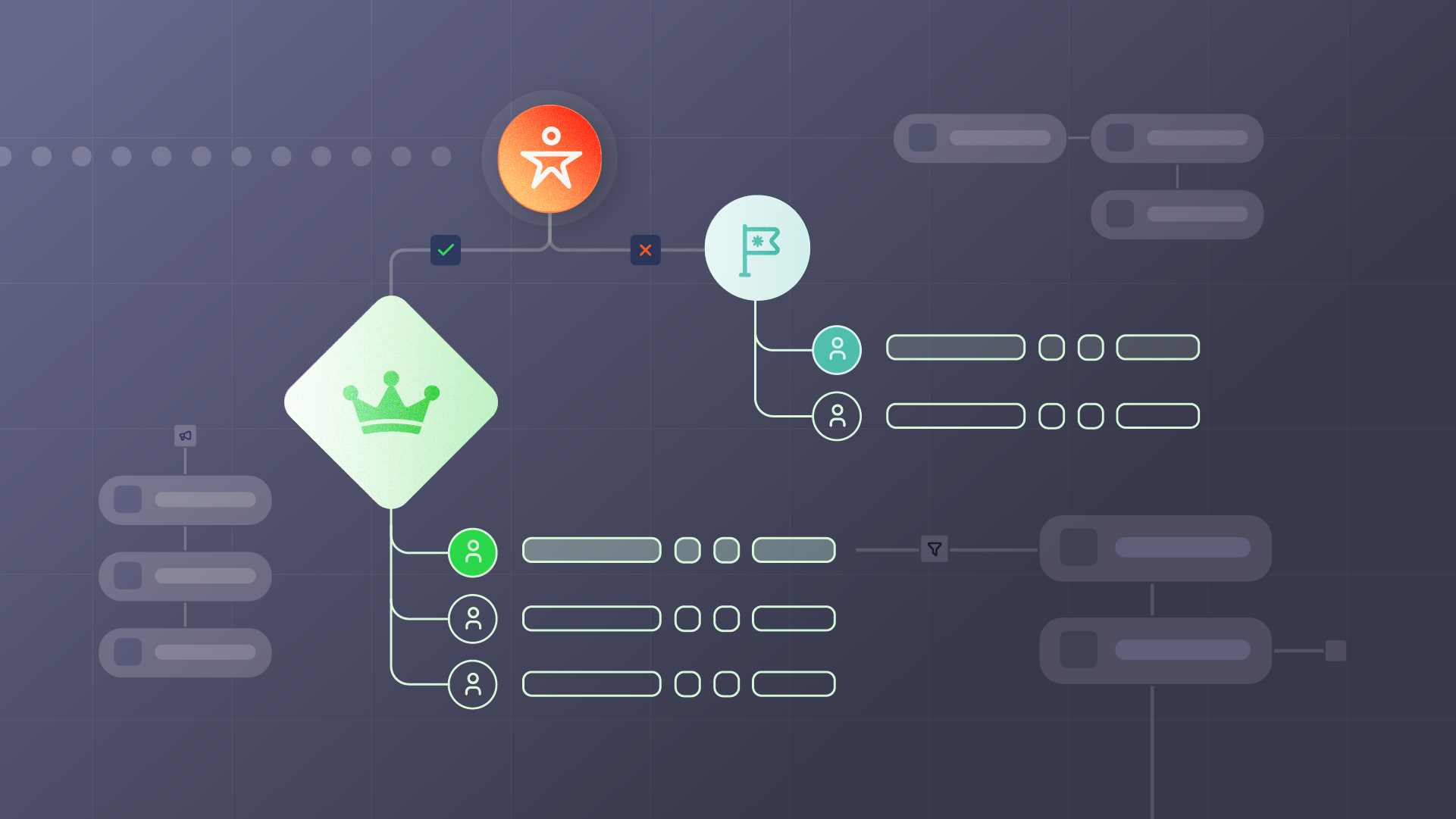Introduction
We recently walked through the most common signs that your company is losing winnable deals. The common denominator is that they all come down to visibility and your sales processes in Salesforce.
Mid-market and enterprise companies have complex networks of employees, decision-makers, and relationships. And they affect not just your sales teams, but the efforts of your marketing and customer success teams as well.
For B2B sales teams, it’s a colossal challenge to efficiently navigate and track this web of relationships.
The harsh truth is that sales teams spend too much time speaking to people who don’t have decision-making power. This often results in deals being blocked by budget holders in the final stages since they weren’t brought into the cycle at the right time.
And that takes away from the deals with a real chance to close. Finding success means qualifying deals earlier and more often – that way, sales reps aren’t wasting time on deals that had no hope, to begin with.
One of the most common solutions to this problem is using an org chart. But today, we’re going to showcase a better solution.
You might also like:
- 3 Salesforce sales processes stopping you from selling more
- Everything you need to know about Salesforce Flow builder vs. lead routing tools
- 5 strategies and tactics to operationalize account-based marketing
What’s wrong with org charts
What’s the best way to visualize the relationships between stakeholders in a buying group?
If your answer was to use an org chart, sadly, they fall short.
For starters, org charts only capture reporting structure and are often built-in tools that reside outside of Salesforce.
Employees get promoted, change jobs, and join and leave the company. It’s difficult enough to keep contacts up to date in Salesforce, let alone in a separate tool like Miro or Lucidchart.
Also, reporting structures don’t paint the full picture. By only tracking the reporting structure at an organization, you may spend all your time focusing on relationships based on the title – instead of those that can actually influence the outcome of the deal.
For example, while you’re building a relationship with a VP of Sales, your deal may be getting derailed by a Director of Sales Operations, who’s a fan of your biggest competitor and already promoting that product to the CRO.
It’s not a relationship map, it’s Complete Influence
So if an org chart isn’t the answer, what is?
It’s time to introduce Traction Complete’s newest Salesforce native solution, Complete Influence.
Relationship maps help you track organizational structures. We know there’s more to it than just relationships and Complete Influence helps get you closer to the right person to close the deal.
Our influence maps allow you to track how strong a relationship is and the decision influence that a person has in a deal. This empowers sales reps to identify the key players in a buying cycle and ensure that their efforts go towards building strong connections with the individuals that matter.
 This is done by tracking advocacy levels and allowing users to grade a relationship based on one of three levels:
This is done by tracking advocacy levels and allowing users to grade a relationship based on one of three levels:
- Low (detractor, fan of the competition)
- Medium (neutral)
- High (Promoting your product when you’re not around)
Influence maps also allow you to grade relationships based on decision influence:
- 1 (no influence on the deal)
- 2 (little to no influence on the deal)
- 3 (the decision maker is consulting with this person)
- 4 (they have the ability to sway the decision)
- 5 (has the authority to decide which tools and projects get funding)
 You might be asking, why do both of these grades matter? Aren’t they one and the same?
You might be asking, why do both of these grades matter? Aren’t they one and the same?
It’s important to distinguish who your sales reps build relationships with. Is it someone at the director level that has a high level of influence? Or someone who has a better title (VP) but little influence in the decision?
Influence maps help you identify the important players in a deal. Will this person support and do the selling on your behalf when you’re not there? Or are they the opposite – maybe they support a competitor and are a threat to you closing the deal?
Complete Influence empowers you to identify these players, plan your sales strategy around them, shift their influence, and even work to minimize any negative impact.
How an influence map helps (and why you need one)
Besides being able to keep track of individuals based on relationship and influence, Complete Influence plays a major role in boosting the efforts of your entire go-to-market team.
Better notes in less time
Using the opportunity contact role in Salesforce doesn’t track details about relationships easily or visually. And mapping relationships outside of Salesforce hurts your sales potential.
Complete Influence keeps important details in Salesforce and is easy for sales reps to use. By automatically pre-populating Contact records, all reps have to do is drag them onto the canvas and draw a line. They can even capture notes and next steps on the influence map.
This means reps can keep track of organizational politics, initiatives, and pain points in a single place.
Better data means better deals
Your best deals shouldn’t be unicorns – Complete Influence can help with that.
Being able to capture valuable data around successful sales cycles, such as which roles tend to carry more influence, and the average number of decision-makers involved, means that sales can turn one-hit wonders into textbook plays.
With Complete Influence, everything entered into the influence map is synced with fields on the contact record and opportunity contact roles, meaning your reps never have to input their notes twice.
Better visibility
Having visibility into relationships doesn’t just affect your sales team. It plays a major role in the efforts of marketing, customer success, partnerships, and even with the leaders.
With the details and relationships visible in a central place, sales leaders can quickly gather the context they need to spot single-threaded deals or gaps that might put a deal at risk. Instead of wasting time trying to understand who’s who on the buyer’s side, leaders can jump in quickly, provide effective 1:1 coaching and esure reps always have meaningful next steps to progress deals.
Other teams like customer success and marketing can also jump in and gain an understanding of the landscape of ongoing deals – without having to dig around and make sense of scattered sales notes.
This means faster ramping, better collaboration to land and expand across accounts, and better forecasting.
Conclusion
Complete Influence is about more than just relationships.
Knowledge is power and having the context of different players, the stakeholders with influence, and a central source of truth will help close more deals.





